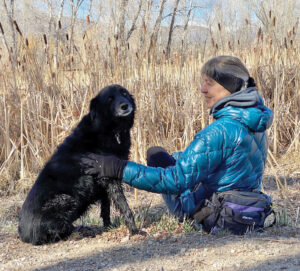By Tina Mitchell
Among the last species of breeding birds to arrive from their South American wintering grounds, Common Nighthawks zip and zoom through the dusk and dawn skies starting in late May and early June. A nighthawk has a big head with large eyes set on each side; its small bill opens to reveal a huge mouth; and it has short legs and weak feet. The precise coloring of nighthawks varies with the predominant color of the region’s soil: They appear grayer or buffier in Central Colorado; in the Southwest, they look more reddish brown. This cryptic coloring provides excellent camouflage to evade predators—or even harmless viewing by a human. If you don’t see a nighthawk fly in and land, I dare you to spot one roosting lengthwise on a limb or resting on the bare ground. The white rectangular patch bisecting the outer wing gives the dark wingtips the shape of an isosceles triangle. (And you thought geometry would never matter in your life.) In flight, the male shows a white tail band (females typically don’t) and a more distinct white streak at the throat (a buffier color in females). Good luck spotting those differences, though, as the birds flutter and soar hundreds of feet above you in the darkening evening sky.
Despite such ID challenges, a nighthawk’s bounding, darting, erratic flight and long, pointed wings make it nearly unmistakable in the air. Although the bird’s gaping mouth enables it to gobble down large moths mid-flight, it also scoops up just about any insect flying at twilight—even winged stages of ants, small flies and mosquitoes. (Hurrah for nighthawks!)
Even if you can’t see them, you can often hear a Common Nighthawk’s buzzy “peeent” call in flight. A male Common Nighthawk makes himself known in a second way. From a moderate height, he dives straight toward the ground. As he pulls up from the dive, air rushing through his flight feathers creates a booming “roar” that sounds very non-bird-like. The first time we camped on our property in Fremont County, we thought we were hearing a mountain lion. (Yes, we were real city folks.) Several weeks later, as I listened to a tape of night sounds, this booming roar issued from my car speakers! Mystery solved (and campers relaxed). This dive is part courtship, part territorial defense, part who knows what else.
Once the birds arrive, they waste little time starting to nest. In Colorado, females lay eggs mid-June to mid-July. The meager nest typically consists of two eggs resting on bare ground, blending with the soil and rocks in the area as does the incubating female. The eggs hatch after three weeks; the young sit quietly near the nest, also well camouflaged and fed by regurgitation by both parents. First flight for the youngsters comes 17?18 days after hatching, and the kids can feed themselves independently as early as 25 days after hatching. Enjoy the birds in the next two months; by late August, they begin their southward migration.
The Common Nighthawk’s scientific name is Chordeiles minor. The genus name refers to the nighthawk’s twilight call: Khorde (from Greek) refers to a chord or note of a lyre; and deile, evening. Assigned when very few species had been documented, the species name (minor) reflected the fact that this species was smaller than the only other known member of this family at the time, the European nightjar. (Today, a smaller member of the Chordeiles genus—the Lesser Nighthawk—also occurs in the U.S. So much for “minor.”) The “common” part of the popular name derives from the fact that it is, indeed, the most common nighthawk in the U.S.; “night,” from its hunting as night falls. “Hawk,” though, is a misnomer, since it is not a hawk at all. Nobody’s perfect.
Folklore from the 1st century held that birds in this avian family came to goats in the evening to suck milk from them. We now know that some in this family—the smaller but similar-looking nightjars such as Common Poorwill, Chuck-will’s-widow—flew near the ground to feed on insects probably stirred up by the goats. Nevertheless, all of these species are sometimes collectively referred to as “goatsuckers.” In fact, the scientific name for this family group is Caprigmulgidae—“goat milker.” Really. You can’t make this stuff up.
After 25 years of watching the natural world in Colorado, Tina now watches it in San Diego County, California. There she works to protect her tiny corner of the planet through wildlife rehabilitation and outdoor education with elementary school kids—two load-bearing columns of Nature’s future.
The Natural World is generously sponsored by Ann and Henry Klaiman.


